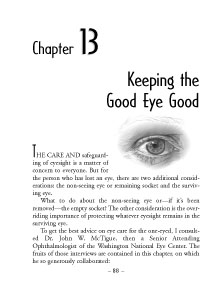 |
| In this chapter, Mr. Brady deals with care of both the unseeing eye (or socket) and the remaining eye. "If your damaged eye has been removed by surgery (enucleated), care of the remaining socket is usually very simple. Should you decide on a "glass eye" for cosmetic reasons, make sure it's well fitted by an expert; a poorly fitted shell can irritate the conjunctiva, the mucous membrane that lines the eye lid. This or any other irritation of the socket--from infections, foreign bodies, etc.--is usually not serious, provided you have it treated promptly by an ophthalmologist. The socket may surprise you by continuing to perform many of the functions of a normal eye socket, such as blinking, winking, and even shedding tears, since the lids and tear glands are still in working order." (pg. 94) "Even small, subtle changes in vision can become important when you've lost an eye, and you'll probably be much quicker to notice them than you used to be. It may be necessary to test your eyesight for glasses more often now; some one-eyed patients need a refraction, as this test is called, as frequently as every four months." (pg. 95) Chapter 1. An Unhappy Landing Chapter 2. An Awkward Takeoff Chapter 3. Jolts of Reality Chapter 4. Flying High Chapter 5. How About You? Chapter 6. Seeing in 3-D—How It Works Chapter 7. What Has Changed? Chapter 8. Getting Back to 3-D Chapter 9. Avoiding Problems and Possible Mistakes Chapter 10. In the Driver’s Seat Chapter 11. The Active Life Chapter 12. Let Technology Help Chapter 13. Keeping the Good Eye Good Chapter 14. Seeing to Your Looks Chapter 15. Eye-making (Ocularistry) Chapter 16. Driving and Piloting Licenses Chapter 17. For Parents Only Chapter 18. Senior Class Chapter 19. In Good Company Glossary Resources |